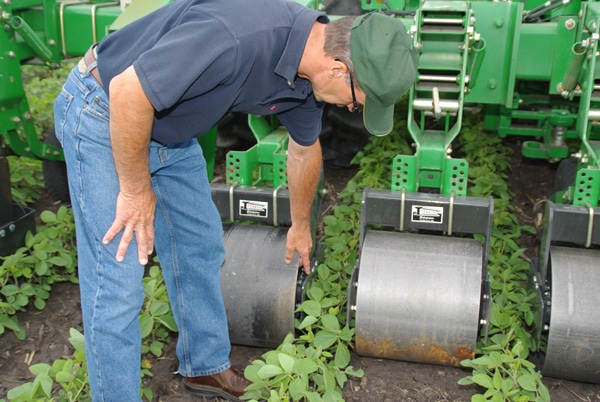January 1, 2012

Jason Zimmer’s heart sank every time he looked at the field. The west-central Minnesota farmer had rolled a quarter-section of soybeans the day after planting, in May 2010. The soil was a bit tacky, and the big roller caused the moist ground to crust, hindering emergence.
“Rolling hurt my stand bad,” he says. Stands dropped 30% on the slopes and hills – a big price to pay for harvest ease.
This spring, it was again wet at soybean planting. That’s when Zimmer decided to skip using a big land roller and, instead, try his neighbor’s new invention.
The Culti-Roller, invented by Clara City, MN, farmer Milt Wubben, is a cultivator retrofitted with drums instead of shanks. It pushes down corn root balls and small rocks in the row middles, leaving soybean plants untouched. When combined with trash wheels on the planter, it does the same job as a full land roller at less cost, and with fewer environmental and production risks, he claims.
Rolling between the rows also extends the window for ground rolling by a good six weeks, easing the labor crunch at planting time, and giving more time to pick rocks before rolling.
Just as important, Wubben says, waiting to roll until plants are standing reduces erosion and blowing residue, and keeps the soil open to absorb spring rains.
And it’s a new use for that idle cultivator in the back of the shed, he adds.
Jason Zimmer rolled a 145-acre soybean field on July 5. Soybeans were about 6 in. tall, and soil conditions were good for rolling. “It did everything I wanted it to do. It smashed the dirt out of the root balls, pushed them down and leveled the soil. And it didn’t hurt the plants in the row. I’m very impressed.”
Inventor Milt Wubben came up with the idea for the Culti-Roller last spring as he was planting soybeans into corn residue. His planter’s trash wheels were windrowing the big root balls between the soybean rows. “I started thinking of what tools I could use to smash them down.”
He’s not a fan of the big land rollers, which have become popular in the last few years. “I’ve stayed away from them because of the conservation risks.”
Recent research from Minnesota, Iowa and North Dakota shows that rolling increases the chances of soil sealing and wind erosion in fine-textured soils and also lowers water infiltration.
“I thought of my cultivator, which I hardly ever used,” Wubben says. What if he replaced the shanks with drums and rolled between the rows, where most of the root balls accumulated?
Mike Tebben, president of Tebben Enterprises, Clara City, made a set of rollers for Wubben’s 18-row John Deere 856 cultivator. The drums, made of ¼-in. wall pipe, are 14 in. wide, except for the end row drums, which are 10 in. wide, and spaced for 22-in. rows.
Each drum is surrounded by a shield, which protects bean plants up to about 12 in. tall. Wubben added double down-pressure springs to his cultivator to increase the packing force. The drums can be filled with water for additional pressure. Each 100-lb. roller unit is fastened with two U bolts.
Tebben manufactures the roller units for 22- and 30-in. row cultivators. The units sell for $550-660. A 33-ft. retrofitted cultivator runs about one-third the cost of a full-width land roller. Tebben also makes a bar gang-roller assembly for growers who don’t have a cultivator.
“It’s a totally new concept in rolling,” Wubben says.
For more information, go to www.tebben.us. Also, see “Rolling Stones,” January 2010 Corn & Soybean Digest, pages 14, 16, 18 or online at http://tinyurl.com/CSDRoll.
About the Author(s)
You May Also Like




